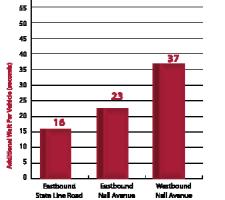
Though still controversial, ramp metering, which has been around for nearly 50 years, continues to deliver substantial benefits, and generally for relatively small cost. Kansas City is a case in point
In March 2010,The ramp metering project was a retrofit low-cost project to bring the proven accident reduction engineering principles of ramp metering to the heartland. There were no ramp or interstate modifications in the implementation of the project, so the cost per intersection was kept to approximately $30,000. KC Scout also implemented a corridor adaptive approach to controlling the ramp signals with CARMA (Corridor Adaptive Ramp Metering Algorithm), an innovative software system. This means that the meters are part of a smart system that allows them to be activated based on traffic demand, but also specifically during the morning and afternoon rush hour periods.
The project had three primary goals: to decrease the number of sudden weaving and braking incidents that happen as vehicles merge onto the freeway; reduce accidents and allow more vehicles to smoothly drive along the freeway; and allow more cars to use the freeway. In short, Kansas and Missouri DOT, responding to the challenging economic times and shortfall of transportation funding, saw the technology solution of ramp metering as an effective, low-cost way to relieve congestion and provide increased safety.
Six month results
Six months after the ramp metering project went live an initial evaluation into the effectiveness of the project was undertaken. Jason Sims, manager of Kansas City Scout, is responsible for the entire ITS programme and all technology deployments."Drivers found that it was easier to enter the highway because of the increased number of gaps in the free flow traffic," he says, adding that there were fewer near miss collisions at the interchanges since the ramp meters were installed.
"Second, on several sections of the interstate, travel times improved in the six months that ramp meters have been activated. Next, motorists have generally accepted the meters, choosing to comply with them rather than ignore them, thereby helping to improve the safety of their commute."
Another notable benefit is that emergency responders were able to achieve faster incident clearance on the freeway after the meters went into operation.
KC Scout is currently completing a one-year report and an entire ramp metering performance study, which will be published on its website. However, from a stakeholder viewpoint - transportation professionals, law enforcement, first responders, and KC Scout traffic management centre operators - it is clear that the programme has delivered what was intended: a low-cost way to relieve congestion and provide increased safety, along with other benefits, along a specific corridor.
So is the negative, or controversial, view of ramp metering purely down to the motorists who encounter it? Not necessarily.
"Some drivers asked for the ramp metering project to be extended farther to the west of Metcalf and implement this technology in other areas of Kansas city," says Sims, underlining that commuters too see the benefits. How many, and how clearly, depends on how ramp metering projects are implemented.
Since the I-435 was the first ramp metering system to be deployed in the region, ITS International asked Sims what lessons had been learned.
"A comprehensive education and media campaign needs to be developed and implemented, at least one year prior to the launch of ramp metering," is his immediate response. "That needs to be targeted not just at motorists and the general public, but also local public officials, technical staff and officials, and law enforcement need to be engaged."
Sims also points to the need to assist each agency with working with their municipal court system to enable effective enforcement of ramp meter violators. And, from an operational perspective, Sims says that an adaptive, traffic-responsive system is required. "Don't pre-time ramp meters. They need to be dynamic and flexible to react to the actual conditions," he adds.
Kansas City Scout, a partnership between the Missouri and
Kansas City Scout focuses on providing real-time traffic information to motorists to increase safety, make informed travel decisions and avoid delays.
The Flip Side - a telling experiment!
The Minneapolis-St. Paul ramp metering scheme was attracting a lot of complaints. As a result, in 2000, Minnesota State Legislature mandated a $650,000 experiment to switch off all 430 ramp meters in the Twin Cities metro area for a period of six weeks. The objective was to definitively evaluate the resulting traffic flow and safety impacts and Cambridge Systematics was appointed to carry out the study, which began with a five-week pre-study data collection in September of 2000.
The objectives of the study included to:
• fully explore the impacts of ramp metering on freeways, local roads, and on transit operations;
• identify the public perception of ramp metering; and
• compare Minnesota's ramp metering system and timing strategies with other regional systems across the country.
When the results were presented, Cambridge Systematics showed that without ramp meters there was a:
• 9 per cent reduction in freeway volume;
• 22 per cent increase in freeway travel times;
• 7 per cent reduction in freeway speeds, which contributed to the negative effect on freeway travel times (the reliability of freeway travel time was found to decline by 91 per cent without ramp meters); and
• 26 per cent increase in crashes, which was averaged for seasonal variations (these broke down to a 14.6 per cent increase in rear-end crashes, a 200 per cent increase in side-swipe crashes, a 60 per cent increase in 'run off the road' crashes, and an 8.6 per cent increase in other types of crashes).
Market research data collection results showed a number of changes in attitudes among area travellers that occurred once meters were switched off, including:
• most survey respondents believed that traffic conditions worsened; and l support for modification of the metering system increased from 60 to 70 per cent of respondents and included such changes as using faster cycle times, having shorter operating hours and using fewer meters.













